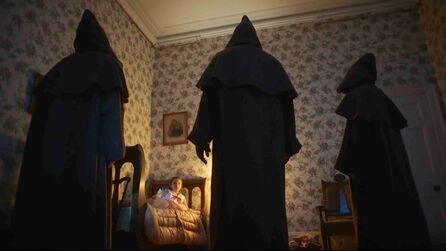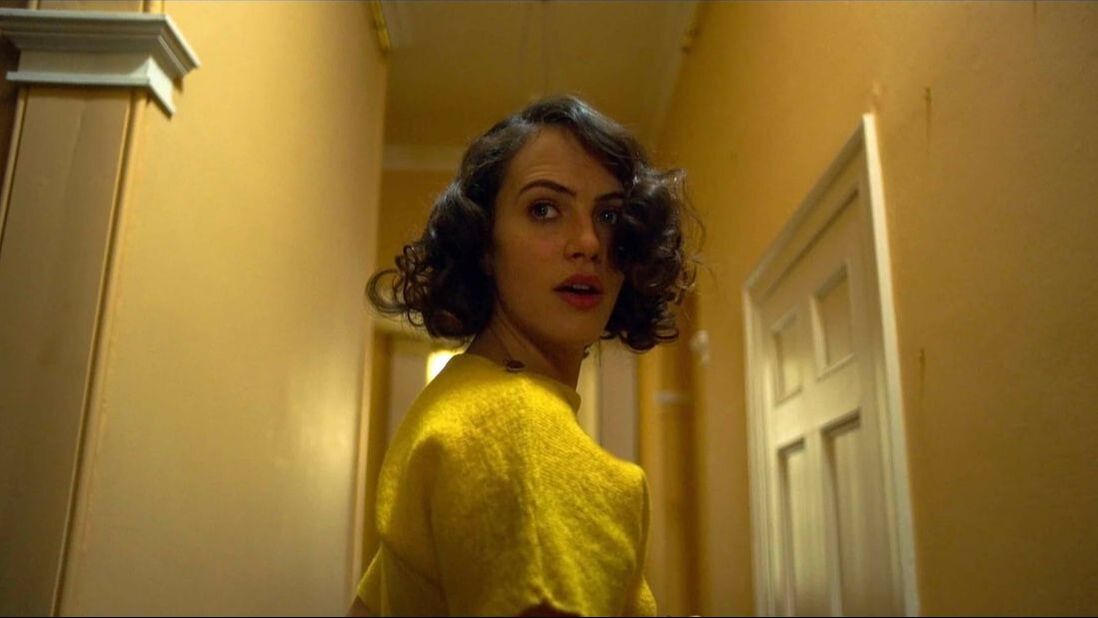 Period piece hauntings are a tricky business these days... ...It’s one of horror’s oldest subgenres, which means creative minds have had decades to play around in the ghostly sandbox digging up various spooky treasures. There may be some gems left in there, buried deep down, but the fact that there’s not much we haven’t seen from a haunting story now necessitates that contemporary filmmakers need to be extra clever if they want their spectral tale to stick. Unfortunately, that’s not quite the case with director Christopher Smith’s latest film, The Banishing, a technically fine piece that loses itself in tropes and trifles despite its otherwise interesting hook. The film, written by David Beton, Ray Bogdanovich, and Dean Lines, is the story of “the most haunted house in England.” It’s the late 1930’s and our heroine Marianne (Jessica Brown Findlay) has arrived in Essex with daughter Adelaide (Anya McKenna-Bruce) to move into a sumptuous if somewhat neglected manor with her husband, Linus (John Heffernan), a vicar recently relocated to the area by bishop Malachi (John Lynch). The house, as you would imagine, is appropriately creepy, all shadows and dim lighting; broken dolls left behind and mirrors draped in dusty tablecloth. Before long, both Marianne and Linus begin to see and hear things in the house, though Linus is quick to dismiss any and all apparitions as nonsense, leaving Marianne to suffer alone, as well as deal with Adelaide’s striking change in demeanor. She eventually learns the secrets of the house’s history from local occultist Harry Price (Sean Harris) and must confront a past both personal and perverse if she wants to save her family. All this occurs against a backdrop of the looming spectre of World War II, and England’s national crisis of conscience on how to handle the approaching conflict. Thematically, a lot works here. Marianne’s disgust at the rise of fascism and her husband’s aversion to sanctioning active resistance against Hitler’s forces provides both a layer of moral subtext as well as pre-existing tension for when the pair once again clashes, this time over the nature of the strange events going on in their new home. Marianne is the doer, the go-getter, wanting to find solutions and solve problems, while Linus prefers to bury his head in the sand, both as it comes to the domestic horror his family is facing and the growing terror abroad. They are shades of one another, a duality reflected in the film’s use of doppelgangers, a storytelling tool Smith previously trafficked in for his excellent psychological mind-warp Triangle (2009). The doubles in The Banishing don’t have quite the same impact as in that earlier film, however, much in the way that the war subplot doesn’t quite coalesce into anything tangible in the narrative. Much as Triangle played with time, so too does this film, albeit in a less mathematical, more ethereal way. These moments where the timeline becomes disjointed make for some of the most unsettling moments in the film—and make no mistake, this movie is unsettling—but there’s something about them that seems unfinished. Even after the film’s dialogue-heavy climax, it’s unclear how the pieces of this strange, peculiar puzzle fit together. Instead, we’re left with a general shape of something that’s good enough, if not entirely memorable. That’s not to say there aren’t solid takeaways from The Banishing. Brown Findlay (Downton Abbey, Brave New World) is wonderful as the put-upon Marianne, struggling to be a supportive wife and mother while staying true to her beliefs amidst this dark presence hounding her family. Her performance is believable and grounded, easily the standout of the cast, though Harris (Possum, Mission: Impossible—Fallout) shines through some hammy writing as the deranged-yet-knowledgeable local savior that’s got a penchant for drama and an axe to grind with the church, represented here by Lynch (The Terror, Black Death) as the equally theatrical bishop Malachi. The film itself looks great, and Smith (Black Death, Severance) is not a bad director by any means. He and cinematographer Sarah Cunningham craft an eerie, oppressive atmosphere reminiscent of The Others (2001) and The Woman in Black (2012). Jump scares are minimal, and those that are there are used at precisely the right time; instead the film relies on its sense of dread and creeping shadows to unnerve the viewer. Ultimately, while The Banishing is unnerving at points, it’s never full-on “scary”, and though individual performers or deliveries stand out, the film itself doesn’t boast enough to separate it from a dozen other generically-titled haunted house outings. It’s not a bad movie, but when one thinks of last year’s The Haunting of Bly Manor or any of the other slow-burn ghosts-in-the-walls films that The Banishing pays homage to—films like The Orphanage (2007) and The Innocents (1961)—it’s hard to get excited for a film with so much untapped potential. Still, the pre-war gothic ambiance, a cowled mad monk gliding through the greenhouse, and serviceable acting make this a good choice for a lazy rainy afternoon. Enjoyable yet forgettable, you won’t need to banish this film from your mind. It’ll fade all on its own. The Banishing comes to Shudder in the US, Canada, UK, Ireland, Australia, and New Zealand, as well as via the Shudder offering within the AMC+ bundle where available on April 15th. By Craig Ranallo
0 Comments
Leave a Reply. |
Archives
March 2023
|


 RSS Feed
RSS Feed